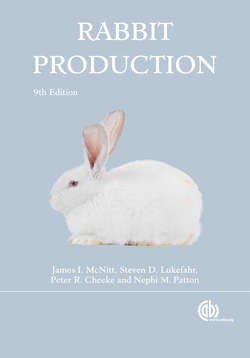Читать книгу Rabbit Production - James I McNitt - Страница 14
На сайте Литреса книга снята с продажи.
Factors Limiting Rabbit Production
ОглавлениеDespite the promising potential of the rabbit as a meat- and fur-producing animal, a number of factors presently limit the profitability of rabbit enterprises. These are related to problems of nutrition, disease, genetics, and the high labor requirement for intensive rabbit production. Much less research has been conducted on the commercial production of rabbits than on the commercial production of other livestock species. Therefore, many more unsolved problems exist, and less information is available on optimal feeding, breeding, disease prevention, and management systems. In the area of nutrition, for instance, it is only since 1970 that data on specific nutrient requirements for energy, protein, amino acids, vitamins, and minerals have been obtained. In most cases, the existing data have been collected in experiments using small numbers of animals, with diets that are not representative of commercial feeds. Thus, much refining of this information is needed through continued research.
Diseases such as enteritis, snuffles, and viral hemorrhagic disease (VHD) are very important factors that prevent rabbit production from reaching its potential. Enteritis is a complex of several diseases that cause diarrhea, dehydration, and death of young rabbits. Until the early 1980s, very little progress had been made in understanding the causes of enteritis. Significant advances in the identification of types of bacteria and dietary factors involved in development of enteritis have been made since that time, but much remains to be done.
In the breeding and genetics areas, there has not been a sustained effort to develop superior breeding animals for commercial purposes. The commercial rabbit industry in the United States has been based on rabbit raisers who have not been in the business for very long. One large processor has characterized rabbit raisers as “one-third coming into the industry, one-third in, and one-third leaving.” The lack of many long-term commercial producers means that there have not been many sustained breeding and selection programs carried out for a sufficient period to make real progress. Some selection in the past has been for traits with a low heritability, such as conception rate and litter size, whereas moderately to highly heritable traits, such as milk production and growth rate, have not received much attention. Development of superior breeding stock, with the potential for high performance in all productive traits, would do much to ensure the growth of the rabbit industry. Another factor that limits the profit potential of large-scale rabbit production is the high labor intensity of rabbit rising. Under present management situations, there is a great deal of hand labor involved in feeding, mating, cage cleaning, and virtually all other facets of rabbit production. This is in contrast to the extensive automation and low labor requirements for poultry production. Once a rabbitry reaches a size above 600 does and hired labor is required, the labor costs become a major factor. Additionally, rabbits require “tender loving care,” and with large rabbitries employing hired labor, this is not always easy to provide. For successful development of large commercial rabbit enterprises to occur in North America and other areas with high labor costs, management systems employing greater automation must be developed.
In contrast, for backyard production in both developed and developing countries, the labor requirements are more or less irrelevant. A few does and their offspring for family meat production are easy to manage, with the care often provided by the children. Diseases, such as enteritis, snuffles, and sore hocks seem to be much less prevalent under these conditions, probably because of a more varied diet and less stressful conditions than animals experience in a large rabbitry. Because of low labor costs and often abundant forage resources, some developing countries may prove to be ideal sites for large-scale rabbitries.
The future is bright for rabbit production. Increasing interest in research on rabbit production at universities and experiment stations throughout the world will undoubtedly provide answers to many of the problems currently plaguing rabbit producers. The nutritional qualities of rabbit meat have resulted in new marketing potentials for rabbit as a “health food” in our increasingly health- and diet-conscious society.
